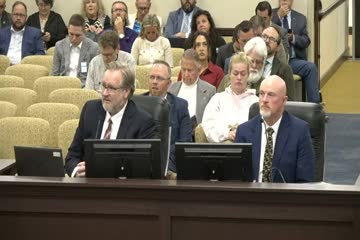Wildlife officials push for urgent predator management reforms
October 16, 2024 | Utah Interim, Utah Legislative Branch, Utah
This article was created by AI summarizing key points discussed. AI makes mistakes, so for full details and context, please refer to the video of the full meeting. Please report any errors so we can fix them. Report an error »

In a recent government meeting, discussions centered around wildlife management strategies, particularly concerning predator control and its impact on deer populations. Representatives expressed concerns about the increasing number of predators, specifically coyotes, and their effect on local wildlife and human interactions.
One representative highlighted the need for new hunting strategies and permits, emphasizing the importance of managing predator populations to protect sheep allotments and mitigate human-wildlife conflicts. The decline in the deer herd was noted as a significant issue, prompting calls for more proactive measures from wildlife management divisions.
Another representative supported a proposed $25 increase in coyote hunting permits, citing rising fuel costs as a barrier for hunters. This increase aims to encourage more hunting activity to control the coyote population, which has reportedly led to numerous roadkill incidents in the area.
The meeting also featured lighter moments, including a humorous exchange about the origins of the term \"mule deer,\" sparked by a question from a representative's granddaughter. This anecdote underscored the community's engagement with wildlife and the importance of educating younger generations about local fauna.
Additionally, representatives commended the Division of Wildlife Resources for their efforts in managing the Great Salt Lake ecosystem, particularly in removing invasive species to benefit waterfowl and other wildlife.
Overall, the meeting reflected a commitment to addressing wildlife management challenges while fostering community involvement and education.
One representative highlighted the need for new hunting strategies and permits, emphasizing the importance of managing predator populations to protect sheep allotments and mitigate human-wildlife conflicts. The decline in the deer herd was noted as a significant issue, prompting calls for more proactive measures from wildlife management divisions.
Another representative supported a proposed $25 increase in coyote hunting permits, citing rising fuel costs as a barrier for hunters. This increase aims to encourage more hunting activity to control the coyote population, which has reportedly led to numerous roadkill incidents in the area.
The meeting also featured lighter moments, including a humorous exchange about the origins of the term \"mule deer,\" sparked by a question from a representative's granddaughter. This anecdote underscored the community's engagement with wildlife and the importance of educating younger generations about local fauna.
Additionally, representatives commended the Division of Wildlife Resources for their efforts in managing the Great Salt Lake ecosystem, particularly in removing invasive species to benefit waterfowl and other wildlife.
Overall, the meeting reflected a commitment to addressing wildlife management challenges while fostering community involvement and education.
View full meeting
This article is based on a recent meeting—watch the full video and explore the complete transcript for deeper insights into the discussion.
View full meeting

